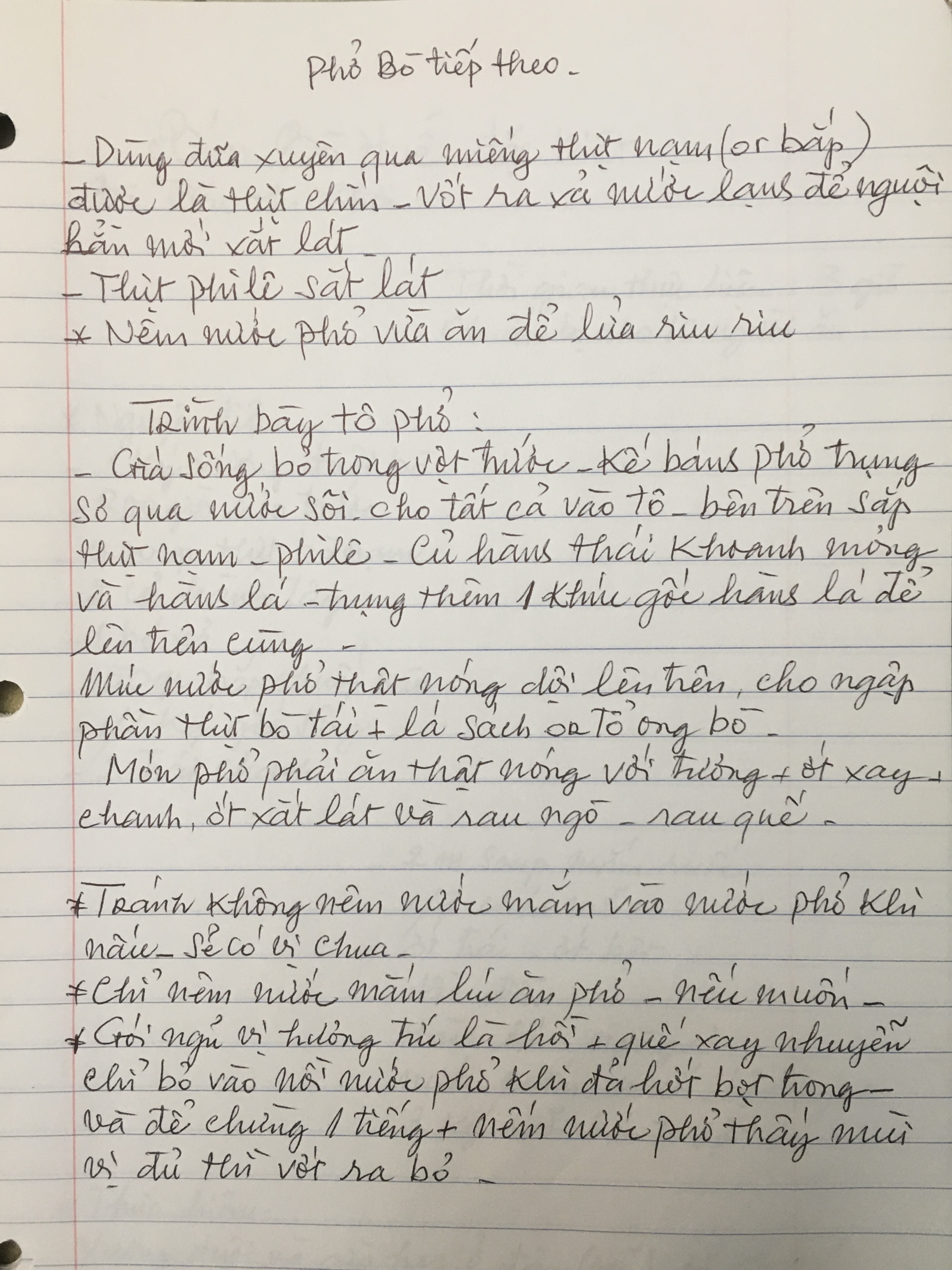

Main Piece:
*preparing for 15 servings
*total time from start to finish: 3 hours
- 1lb of beef bones
- 400g of brisket
- 250g of beef tenderloin (fillet)
- 2 large onions
- 3 limes
- Thai chilis, green onions
- Basil, cilantro
- 50g hoisin sauce
- 20g sriracha
- Salt, pepper, MSG or chicken sugar (chicken bouillon)
- 1lb of rice noodles
- 300g of raw mung bean sprouts
- 1 whole ginger = char the skin
- 3 pieces of star anise
- 1 small piece of cinnamon or one seasoning packet
- Beef bones: soak in warm water to drain the blood out, dump the water and repeat many times
- Wash the brisket with water until clean and let the water drain out
- Wash the beef tenderloin with water until clean, dry with a paper towel, then put in the refrigerator
- Raw mung beans, fresh herbs, Thai chilis and lime: prepare right before serving
Making the Phở Broth
- Pour 12 large bowls of cold water or a little more in the pot and bring to a boil, at the same time, cook the beef bones and brisket in the pot on medium-low heat while it is uncovered. Watch the pot. Film will occasionally form at the top of the broth, skim it off and discard the film. Skim the film many times.
- Turn up the heat little by little so all of the film can form at the top to be removed, keep skimming it off until the water becomes clear. At this stage, you can put in the ginger and onion which should be charred right before putting them in the pot. Season by taste with chicken bouillon, a little salt, and MSG. Lower the heat.
Page Two
- Use chopsticks to pierce the brisket to test if it is cooked properly. If it pierces through, take the brisket out and rinse with cold water and leave it until it completely cools down, then slice it.
- Slice the beef tenderloin
*Taste the broth to adjust seasoning as needed and lower the heat to keep the broth at a simmer.
Plating the Phở
- First put the raw mung bean sprouts in a strainer. Then put the uncooked rice noodles on top, blanch them in boiling water, strain the water and plate both the mung beans and noodles in a bowl. On top, plate the brisket, fillet, sliced onion, and green onion. Also include one piece of green onion about 2-3 inches long cut from the bottom up.
- Pour in the broth (brought to a boil before serving), until the raw tenderloin is covered. Add blanket tripe or honeycomb tripe.
Pho has to be eaten very hot with hoisin sauce and sriracha, lime, sliced chilis, cilantro, and basil.
*Do not use fish sauce to season the broth. It will make the broth taste sour.
*Only add fish sauce to your bowl when you’re eating, if you want to.
*The seasoning packet is ground star anise and cinnamon. Only add to the broth when the broth is clear (all the film was removed). Leave it in for one hour, then taste for proper seasoning. If it’s good, remove the seasoning packet.
Background:
This is my grandmother’s recipe for Phở Bò, which is rice noodles in beef broth. It is an iconic dish of Vietnamese cuisine, however, she only started to make it after immigrating to the United States in the 1990s. She explains that in Vietnam, there were phở restaurants everywhere, so there was never a need to make it yourself at home. Further, since the dish takes so long to make and requires so many ingredients, it was not convenient or accessible for the normal citizen to make it themselves. Unless you owned a phở restaurant, you were not cooking this dish at home. Thus, after immigrating, because the abundance of phở restaurants and general Vietnamese cuisine was no longer a given, my grandmother, like most other Vietnamese people in the diaspora, had to learn how to cook certain dishes themselves. It was through sharing knowledge with others and the coming of the internet that helped my grandmother develop her recipe over time. It is a loved dish for her to make and share with our (very large) family.
Context:
I have been able to visit my grandmother from time to time during the pandemic. It was during one visit where she shared this recipe with me.
Thoughts:
This is one of my favorite foods to eat, so I am delighted to have my grandmother’s recipe. Phở has always been a source of comfort and also healing for when I’m sick. Because so much effort and time are poured into the dish, as well as eating it while it’s practically boiling, the warmth of the cook shines through the meal. I also love phở because a person’s recipe can tell you a lot about their history and where they came from. The inclusion of fresh herbs, lime, among many other toppings shows that this particular recipe follows the style of phở from the southern region of Vietnam. I’ve also had the northern version, which is also delicious, but slightly different in its simplicity: very few toppings are included and the broth is made with a stronger spice base. Furthermore, this dish has changed drastically over time as new variations appear along with newly gained access to more ingredients. The Huy Fong Sriracha is now a staple topping in the southern style phở but clearly was not included in the earlier versions preceding its creation in 1980. Now, you may see variations of phở adorned with lobsters, other seafood, accommodating vegetarian or vegan diets, and many more. Tracking the differences in these variations can thus reveal changes in people’s circumstances, tastes, and trends.
